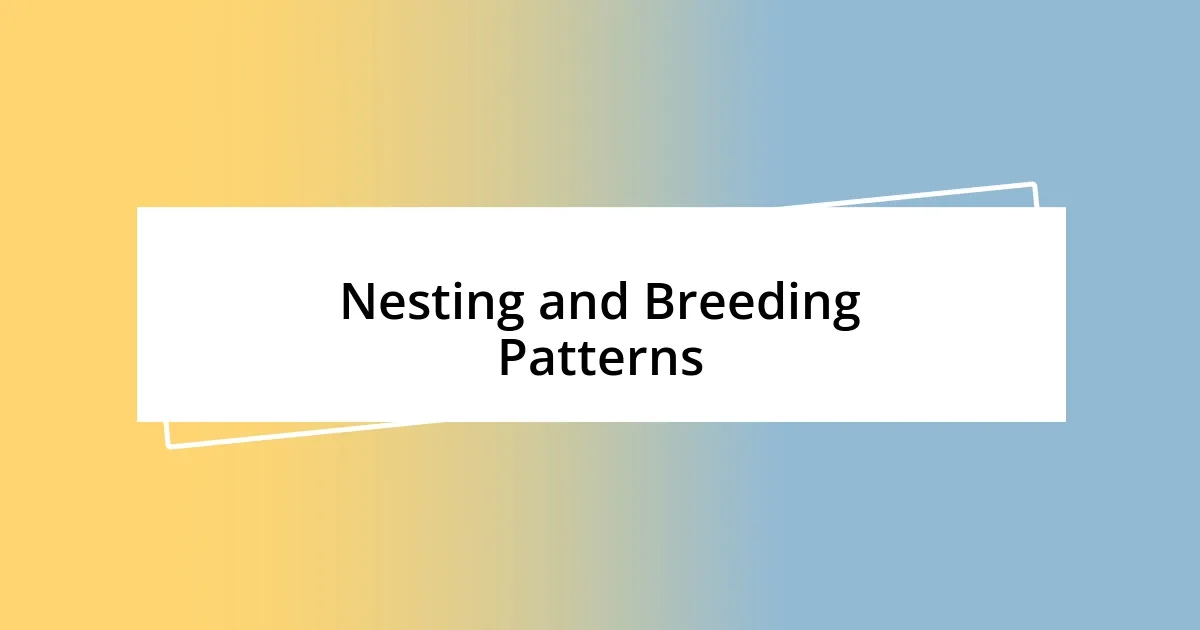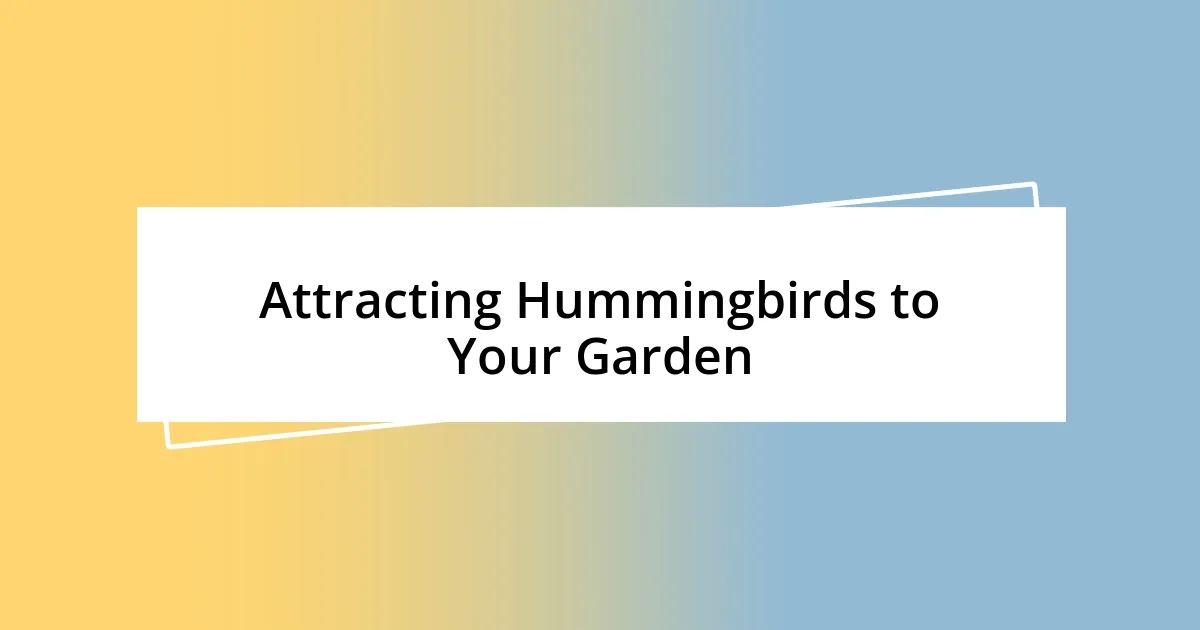Key takeaways:
- Hummingbirds exhibit fascinating behaviors such as territoriality, courtship rituals, and complex social interactions among species.
- Feeding habits are crucial for their survival, requiring them to consume large amounts of nectar and adapt to seasonal changes.
- Nesting and breeding involve meticulous care from females, who protect their eggs and raise chicks in well-crafted nests.
- Migration patterns are instinctual, reflecting their resilience as they travel vast distances and return to familiar territories each spring.

Introduction to Hummingbird Behavior
Hummingbirds are some of the most fascinating creatures to observe in nature. I remember the first time I saw one darting around my garden; it was an exhilarating moment that made me realize how energetic and precise these tiny birds are. Have you ever noticed how they seem to hover almost effortlessly, their wings a blur? This remarkable ability allows them to sip nectar from flowers while expertly navigating their surroundings.
Their behavior is not only about feeding; it’s also about establishing territory and courtship rituals. I once watched a male hummingbird fiercely defend his feeding area, showcasing an impressive display of agility and speed. It struck me that their territorial nature highlights a complex social structure within their species. I often wonder, how do they balance these intense interactions while maintaining such delicate beauty?
What truly captivates me is their migratory patterns. These small birds travel vast distances, often crossing entire countries, which speaks volumes about their resilience and instincts. Just thinking about the determination required for such a journey gives me goosebumps. Have you ever considered what drives a creature so small to undertake such significant adventures? That innate drive is part of what makes hummingbirds endlessly intriguing to observe.

Importance of Feeding Habits
Feeding habits are essential for hummingbirds, as their high metabolism demands constant access to energy. I remember standing quietly in my backyard, watching as one particularly bold hummingbird returned multiple times to my feeder, seemingly fueled by an insatiable need to feed. The rapidity of his visits painted a vivid picture of just how critical these habits are for his survival.
Here are a few key points regarding the importance of their feeding habits:
- Energy Requirements: Hummingbirds consume up to twice their body weight in nectar daily to maintain their extraordinary energy levels.
- Nectar Preference: Different species prefer different flower types, showcasing their adaptability and the importance of flowers in their feeding behavior.
- Territorial Feeding: Males often defend feeding territories, which not only ensures their access to food but also attracts potential mates, highlighting the interplay between feeding and social behavior.
- Seasonal Changes: Their feeding habits shift with migration patterns; they often seek out new food sources as they travel, adapting to changing environments.
- Pollination: As they feed, hummingbirds play a crucial role in pollinating flowers, contributing significantly to the ecosystem’s health.
Observing their feeding rituals often feels like peering into a miniature world of determination and instinct. Each visit to the feeder takes on a story of survival and tenacity, making every glimpse a reminder of the delicate balance of nature.

Social Interactions Among Hummingbirds
Social interactions among hummingbirds are both fascinating and complex. I often find myself drawn to their energetic dance, especially when multiple birds vie for a spot at the feeder. It’s like watching a mini aerial ballet, full of chirps and agile maneuvers as they dart and weave around each other. Have you ever noticed how they seem to have a pecking order when it comes to feeding? In my garden, I observed a smaller male who, despite his size, would persistently chase away a much larger rival. It struck me that even these tiny creatures are aware of their social hierarchy, showcasing their fierce yet nuanced personalities.
Interestingly, their social dynamics extend beyond mere competition for food. I once witnessed two hummingbirds engaging in a courtship display that was nothing short of mesmerizing. The male perched nearby, puffing up his throat feathers and darting impressively back and forth while emitting a series of soft chirps. The female, seemingly unimpressed at first, eventually put on a show of her own, flapping her wings delicately in response. This moment encapsulated a dance of attraction and rivalry, reminding me that their interactions are often layered with meaning, revealing both cultural and personal nuances.
While observing hummingbirds, I’ve also noticed how they sometimes share spaces peacefully. During one warm afternoon, I was delighted to see several different species hovering around my feeder. There was a palpable sense of a temporary truce as they waited for their turns to sip nectar. It made me ponder the unexpected harmony that can exist in the shadow of competition. What a beautiful reminder that cooperation is also part of their social fabric.
| Type of Interaction | Description |
|---|---|
| Territorial Defense | Males aggressively protect their feeding areas from rivals, showcasing strength and agility. |
| Courtship Displays | Males engage in vibrant aerial displays to attract females, often involving dazzling maneuvers. |
| Peaceful Coexistence | At times, multiple species share feeding areas without conflict, demonstrating unexpected cooperation. |

Nesting and Breeding Patterns
Nesting and breeding patterns of hummingbirds offer a glimpse into their incredible adaptability and dedication as parents. One afternoon, as I peered into a dense shrub in my garden, I spotted a tiny cup-shaped nest perfectly camouflaged among the leaves. It made me wonder how such a vibrant little bird could create a sanctuary so discreet. Female hummingbirds meticulously craft their nests using plant fibers, spider silk, and even feathers, creating a cozy home for their young.
When it comes to breeding, timing is everything. I’ve observed females preparing nests just as flowers bloom in spring, ensuring an abundant nectar supply for their demanding chicks. It’s a wonder to see how the female takes on the role of both mother and builder, fiercely protecting her nest from potential threats. This fierce devotion struck me deeply during a quiet moment when a larger bird approached, only to be met with the sharp warning buzz of a defensive female. Have you ever witnessed such an act of courage in a creature so small? It serves as a powerful reminder of the lengths a mother will go to ensure her offspring thrive.
The early days of a chick’s life are captivating, too. I once had the pleasure of witnessing a pair of tiny fledglings as they peered over the edge of their nest, their little beaks wide open in eager anticipation of food. It’s astonishing how quickly they grow, fueled by the constant feedings from their mother. In just a few weeks, they’re ready to embark on their journeys, each one a testament to the nurturing spirit inherent in hummingbird behavior. This cycle of life is a vibrant dance of continuity and resilience, connecting generations in ways that humbling beauty often reveals.

Seasonal Migration Trends
When autumn approaches, the sight of hummingbirds preparing for migration always brings a sense of wonder. I remember standing in my backyard one evening, a chill in the air, as I watched a group of ruby-throated hummingbirds gather near my feeder. It was as if they were having a meeting, energetically buzzing around, filling the twilight with their chatter. Their instinctual drive to migrate, sometimes thousands of miles, reminds me of a calling we all feel in different ways. Have you ever felt that pull toward a place that just feels like home?
As these tiny travelers head south, I can’t help but feel a bittersweet mix of emotions. It fascinates me how they know when to leave—responding not only to changes in temperature but also to the availability of flowers. I once spotted a single hummingbird lingering long after the others had flown. I wondered if it was reluctant to leave or simply waiting for one last sip of nectar. Watching its determination ignited a deeper appreciation for these delicate birds that brave such long distances, reminding me of our own journeys through change and the seasons of life.
Tracking their migration patterns throughout the year, I’ve begun to notice familiar faces returning to my garden in spring. It feels almost like a reunion; these birds don’t just come back to feed, but reconnect with the habitat they once called home. Seeing them flit about, claiming their territory again, makes me ponder how they remember these places so well. Considering their short lifespans, it’s astounding how their migratory routes are etched in their genetic memory. Have you ever felt the joy of recognizing something or someone that brings back memories? For me, each returning hummingbird feels like a burst of life, a small miracle that ties back to the cycles in nature we often overlook.

Attracting Hummingbirds to Your Garden
To attract hummingbirds to your garden, consider incorporating a variety of flowering plants that provide plentiful nectar. From my experience, vibrant colors, especially reds and oranges, seem to catch their attention. I once planted a handful of trumpet vines and was delighted to see hummingbirds hovering around them within days. It’s remarkable how a simple addition can transform your garden into a hummingbird haven.
Another effective tactic is to provide reliable food sources, like hummingbird feeders filled with a sugar-water solution. I typically mix one part sugar with four parts water, boiling the mixture to ensure it’s safe for our feathered friends. One summer, after I hung my first feeder, I was amazed to witness a hummingbird return several times a day, practically staking its claim. Have you ever marveled at how persistent they can be when they find a good feeding spot?
Lastly, creating a welcoming environment by including shrubs for shelter and perches will encourage them to visit. I often see hummingbirds perch on my garden stakes or nearby branches, keeping an eye on the area. It’s not just about food; they appreciate a safe place to rest as they zip from blossom to blossom. Reflecting on your own garden, what elements could you add to make it more inviting? With a few changes, you might just find your garden buzzing with life.

Observational Techniques for Birdwatching
Observing birds takes patience and an openness to the unexpected. I remember my first time settling in with a pair of binoculars. I chose a quiet spot by the window and let the world outside unfold. It was astonishing—the variety of birds I hadn’t noticed before became vivid, each with their own quirks and habits. Have you ever watched a bird and felt as though it was aware of you? That brief connection can be incredibly moving.
One invaluable technique I’ve found is to keep a journal of my observations. Each time I sit quietly, I jot down details—what the birds are doing, their colors, and the sounds they make. There’s something special about capturing moments on paper; it deepens my appreciation for the species around me. After a full season of diligent note-taking, I’m often surprised to see patterns emerge. Do you think you could find hidden stories in your backyard experiences?
Additionally, blending into the environment can make a world of difference in birdwatching. I learned to wear neutral clothing and to keep my movements subtle, especially when I’m near feeding stations. One afternoon, while standing still behind a bush, I was rewarded with a close-up view of a female hummingbird feeding. That feeling of being part of their world was exhilarating. How often do we fully immerse ourselves in nature? I believe these moments can remind us of the beauty in slowing down and simply observing.














